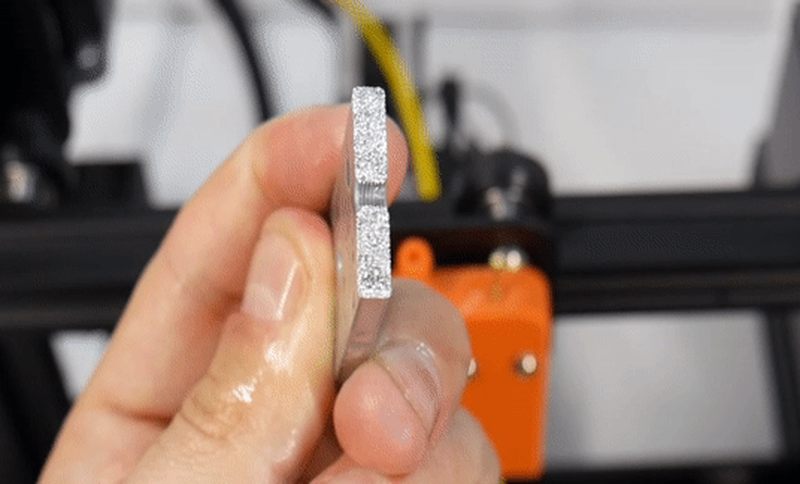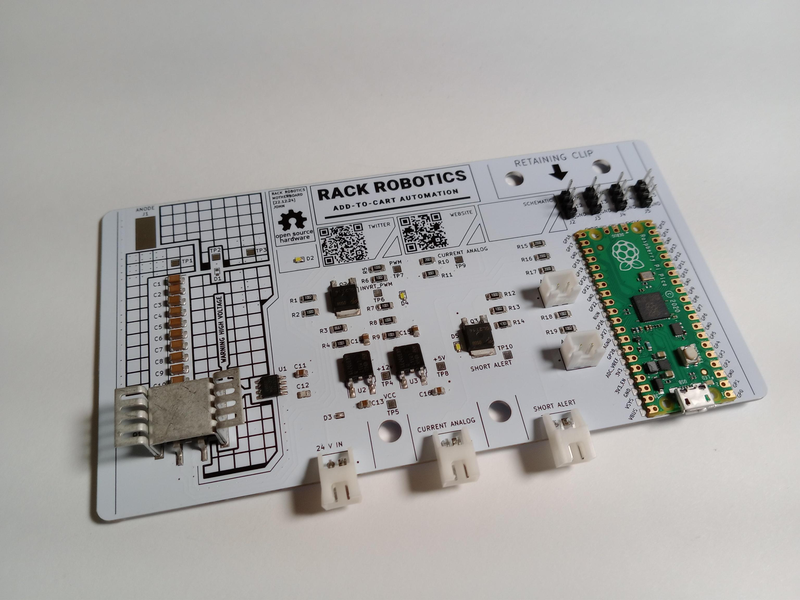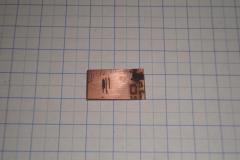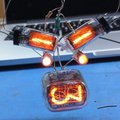-
Hack Chat Transcript, Part 2
01/18/2023 at 21:05 • 0 comments![]() Idea. A plastic bag, acting as an enclosure. Big enough and mobile enough to allow the tool moving around. Mild overpressure inside to keep it inflated to stay out of the way. Should contain the splatter.
Idea. A plastic bag, acting as an enclosure. Big enough and mobile enough to allow the tool moving around. Mild overpressure inside to keep it inflated to stay out of the way. Should contain the splatter.![]() Thomas - not resin, but 3D printed plastic tooling I made:
Thomas - not resin, but 3D printed plastic tooling I made: It leaks through things you thought were sealed, precision surfaces are destroyed, common of-the-shelf tooling is usually made of some carbon steel and it rapidly rusts.
![]() Yes. I've damaged expensive linear rails beyond repair with ECM
Yes. I've damaged expensive linear rails beyond repair with ECM![]() What do you use for the electrolyte? I think I saw sodium chloride is used sometimes?
What do you use for the electrolyte? I think I saw sodium chloride is used sometimes?![]() Oh, that's sweet! I thought about printing a negative shape, you just deposit metal on top of a printout.
Oh, that's sweet! I thought about printing a negative shape, you just deposit metal on top of a printout.![]() @Thomas Shaddack I have played around with using rubber sheeting, way covers, plastic bags, and tubing to try and protect RepRap ECM machines from electrolyte corrosion. It is very difficult because the hydrogen/oxygen forms water droplets as it escapes, carrying the corrosive and poisonous vapor around the room/machine.
@Thomas Shaddack I have played around with using rubber sheeting, way covers, plastic bags, and tubing to try and protect RepRap ECM machines from electrolyte corrosion. It is very difficult because the hydrogen/oxygen forms water droplets as it escapes, carrying the corrosive and poisonous vapor around the room/machine.![]() Yep! That was a few years ago though. I've since switched to EDM because I'm not shooting for nanometer precision
Yep! That was a few years ago though. I've since switched to EDM because I'm not shooting for nanometer precision@anfractuosity - our standard electrolyte is sodium nitrate but we experiment with a wide range of electrolytes including concentrated acid or base
![]() Hence the plastic bag. A sealing membrane over the water-air interface. What could also work is some sort of covers over the rails/screws and keeping that at mild overpressure so the air current blows away the corrosive aerosols.
Hence the plastic bag. A sealing membrane over the water-air interface. What could also work is some sort of covers over the rails/screws and keeping that at mild overpressure so the air current blows away the corrosive aerosols.![]() Would a layer of oil on the surface prevent the aerosolization?
Would a layer of oil on the surface prevent the aerosolization?And in case you were wondering, when you spring a leak and that electrolyte sprays on a VFD, it tends to catch on fire. The joys of using a very conductive electrolyte around electronics...
![]() For DIY J-ECM I used table salt and detergent too good effect. Perfect for micromachining aluminum.
For DIY J-ECM I used table salt and detergent too good effect. Perfect for micromachining aluminum.![]() I also used table salt when I experimented with JECM
I also used table salt when I experimented with JECM![]() Does it leak under pressure or just trickles out? The latter can be approached in the similar way the dykes and dams are around big oil tanks in refineries, to contain the spills and redirect them where they can be handled easier.
Does it leak under pressure or just trickles out? The latter can be approached in the similar way the dykes and dams are around big oil tanks in refineries, to contain the spills and redirect them where they can be handled easier.![]() Plasma electrochemistry is no different than wet electrochemistry, just dealing with water for cooling and ions. Gas mixtures just change the chemistry at the electrode. Electron and ion implantation and machining can be done in vacuum air or water. All these technologies are part of using electrons and ions and neutral particles for practical things.
Plasma electrochemistry is no different than wet electrochemistry, just dealing with water for cooling and ions. Gas mixtures just change the chemistry at the electrode. Electron and ion implantation and machining can be done in vacuum air or water. All these technologies are part of using electrons and ions and neutral particles for practical things.![]() ion implantation IN WATER?!?
ion implantation IN WATER?!?One of the biggest challenges we find is that there are all sorts of interested ideas in the litterature about organic electrolytes or electrolyte combinations but they often don't scale well so that you can recirculate it in a closed system and actively control the conductivity, temperature, ph, etc.
![]() Thomas - bc of the high currents involved it is necessary to have very high flow to prevent boiling. Most leaks would result in a large spray or misting of electrolyte
Thomas - bc of the high currents involved it is necessary to have very high flow to prevent boiling. Most leaks would result in a large spray or misting of electrolyte![]() The nonscalable approaches can still have merits for one-off DIY-class component.
The nonscalable approaches can still have merits for one-off DIY-class component.![]() ARGH. The high flow is the fly in the ointment.
ARGH. The high flow is the fly in the ointment.![]() What kind of control systems are needed for the ECM process? I know EDM needs pretty tight control to keep the arc consistent, but it seems like ECM might be a "kinder, gentler" process
What kind of control systems are needed for the ECM process? I know EDM needs pretty tight control to keep the arc consistent, but it seems like ECM might be a "kinder, gentler" process![]() If you can think of it, and search, you will find many people who have been at it for decades. I started with electrochemistry 55 years ago. The learned electrodynamics and try to keep up with all 3D scanning and replication technologies.
If you can think of it, and search, you will find many people who have been at it for decades. I started with electrochemistry 55 years ago. The learned electrodynamics and try to keep up with all 3D scanning and replication technologies.![]() Sadly, the organic additives are very hard to get for DIY folks, so it is not too useful for small scale ECM attempts
Sadly, the organic additives are very hard to get for DIY folks, so it is not too useful for small scale ECM attempts![]() John - this is true. I've had great success with EDM using plain old tap water
John - this is true. I've had great success with EDM using plain old tap water![]() What are the additives? There are DIY chemists of NileRed class out there, and you can get to anyone through six degrees of separation through friend-of-a-friend networking.
What are the additives? There are DIY chemists of NileRed class out there, and you can get to anyone through six degrees of separation through friend-of-a-friend networking.![]() How about stability of electrolyte over time? It last long, need to be replace over some time or something else?
How about stability of electrolyte over time? It last long, need to be replace over some time or something else?![]() For example, here's another pic of an EDM cut with tap water
For example, here's another pic of an EDM cut with tap water![]()
![]()
![]() Can the electrolyte be regenerated? Get the dissolved metals out by plating them onto an electrode?
Can the electrolyte be regenerated? Get the dissolved metals out by plating them onto an electrode?The control in ECM is relatively straight forward. We build around a Beckhoff controller but any controller can work. Mostly you are controlling the voltages, pulse widths, electrolyte conditions, and position of the tool. The hardest part is that you cannot directly measure the gap between the tool and the electrode in process (but I am open to ideas on this!). Many academic researchers have tried. It is not too hard to check the gap in the middle of the run but all you are doing is checking the minimum gap in one location - and you don't know where that location is. Similarly, the current you are drawing is a measure of the average gap but you don't know how much the gap varies.
![]() @Cooper If you are using tap water that is low conductivity. So it is closer to doing EDM which is just electrical machining in air or gas. If you use distilled water and circulate, it might be close to EDM but cooler.
@Cooper If you are using tap water that is low conductivity. So it is closer to doing EDM which is just electrical machining in air or gas. If you use distilled water and circulate, it might be close to EDM but cooler.![]() Can the bugbear Cr(VI) be reduced electrochemically, possibly to chromium itself? Possibly using a membrane electrolyzer?
Can the bugbear Cr(VI) be reduced electrochemically, possibly to chromium itself? Possibly using a membrane electrolyzer?![]() @RichardCollins The above pic is EDM, not ECM
@RichardCollins The above pic is EDM, not ECMWe try to stay away from additives in ECM - they just complicate the process and can degrade or change the condition over time. The electrolyte control system adds some chemistry over time to keep the system balanced and we also remove the sludge waste on some regular interval for waste recycling.
![]() so in principle similar to the systems used to keep pool water chemistry in balance, or handle the hydroponics solutions?
so in principle similar to the systems used to keep pool water chemistry in balance, or handle the hydroponics solutions?![]() @Cooper I was trying to explain that you can keep track of the conductivity and properties of the environment - water, air, gas, cryogenic gas, plasma, vacuum -- and treat all these with one set of equations. The cutting properties can be calculated from first principles for all of these methods - in any combination. Not just seat of the pants ball park guessing. And all the conditions for the cutting can be measured and monitored, and use for planning and optimization.
@Cooper I was trying to explain that you can keep track of the conductivity and properties of the environment - water, air, gas, cryogenic gas, plasma, vacuum -- and treat all these with one set of equations. The cutting properties can be calculated from first principles for all of these methods - in any combination. Not just seat of the pants ball park guessing. And all the conditions for the cutting can be measured and monitored, and use for planning and optimization.There is a field of electrochemistry called electrowinning about plating materials from a bath. It is not as easy as you might think because plating is very particular about the chemistry. For example, it is not too hard to plate the nickel but that still leaves behind the molybdenum which is a problem. I know companies that have done this in very high volume applications but usually it is not economic.
![]() We don't have to be perfect. Let's aim for harm reduction instead of perfection. Perfect is a bad enemy of done.
We don't have to be perfect. Let's aim for harm reduction instead of perfection. Perfect is a bad enemy of done.![]() @Daniel Herrington two things: Beckhoff PLC from as far as i know are very fast, so there is high chance that other controller not work as good.
@Daniel Herrington two things: Beckhoff PLC from as far as i know are very fast, so there is high chance that other controller not work as good.For gap measuring: do you try measure gap capacitance?
![]() I am not feeling well, I have to go. Thank you for the presentation.
I am not feeling well, I have to go. Thank you for the presentation.@RichardCollins - the first principles approach gets you in the ballpark but there are some other variables that throw that off such as the current efficiency of the metal removal or the mass transport of electrolyte through the system. We always start with the first principles approach - i.e. how fast could we theoretically go - and then use that to compare with what rate we are actually seeing to figure out how well our process is working.
![]() Electrowinning is a big part of mining and refining processes, as I recall
Electrowinning is a big part of mining and refining processes, as I recall@Piotr - Yes we have tried things around gap capacitance but honestly haven't made it very far. Maybe an area for us to explore more
![]() Thomas - when it comes to harm reduction, why even take the chance with maker-tier ECM? I love using ECM, but it just hasn't been DIY friend IME
Thomas - when it comes to harm reduction, why even take the chance with maker-tier ECM? I love using ECM, but it just hasn't been DIY friend IME@Thomas Shaddack - if you just strain Hex Chrome water through iron balls, you will reduce the chrome to trivalent. Although sometimes it won't get reduced. Companies like Hach sell colormetric kits for measuring hex chrome and they aren't too expensive so that would be a good safety measure to at least understand what you are working with.
![]() "Part is not made" is part of the harm equation on the "do nothing" side.
"Part is not made" is part of the harm equation on the "do nothing" side.![]() I love what it can do for aerospace and large scale manufacturing. Recently my experiences with EDM have been far more fruitful than years playing with low level ECM
I love what it can do for aerospace and large scale manufacturing. Recently my experiences with EDM have been far more fruitful than years playing with low level ECM![]() OK, wow -- that was a whirlwind chat! I've been wanting to do an ExM chat for a while, and this did not disappoint! I learned a ton, thanks so much Daniel for your insights here today. And thanks to everyone for the great questions and for sharing your experiences. I'm looking forward to a ton of new DIY projects in the ExM space!
OK, wow -- that was a whirlwind chat! I've been wanting to do an ExM chat for a while, and this did not disappoint! I learned a ton, thanks so much Daniel for your insights here today. And thanks to everyone for the great questions and for sharing your experiences. I'm looking forward to a ton of new DIY projects in the ExM space!![]() @Cooper That is why I have been collaborating with you to make open source EDM a reality. I really enjoyed ECM, but it is not as fun or friendly as EDM
@Cooper That is why I have been collaborating with you to make open source EDM a reality. I really enjoyed ECM, but it is not as fun or friendly as EDMI would agree with @Cooper. ECM is hard but makes sense in volume production. I build my own ECM machine but it has taken years to understand how to use it well and manage all of the variables.
![]() after I write I thought that maybe electrolyte because of being conductive is not perfect for capacitance. Try this: https://en.wikipedia.org/wiki/Spread-spectrum_time-domain_reflectometry :D
after I write I thought that maybe electrolyte because of being conductive is not perfect for capacitance. Try this: https://en.wikipedia.org/wiki/Spread-spectrum_time-domain_reflectometry :D![]()
![]()
![]() Here is some early attempt I did with EDM for circuitboards. Handheld electrode under a drop of vegetable oil. Capacitor discharge at low voltage.
Here is some early attempt I did with EDM for circuitboards. Handheld electrode under a drop of vegetable oil. Capacitor discharge at low voltage.![]()
https://www.improwis.com/projects/method_EDMdischargeCircuitboardEtching/
Method under development - EDM machining of circuitboards
A printed circuit board is a heart of modern electronics. There are many ways to make one at home - photoresist, laser engraved resist, manual scribing, CNC milling, and others... and all of them suck in one or another way, mostly by requiring costly precursors, machines, or being finicky and prone to process variables.
![]() Cooper and I will be releasing our open source EDM motherboard soon. We want everyone to have the power to machine metal at home, on their own 3D printer
Cooper and I will be releasing our open source EDM motherboard soon. We want everyone to have the power to machine metal at home, on their own 3D printer@Dan Maloney - Thanks for letting me join this Hackchat!
![]() Thanks for stopping by, Daniel
Thanks for stopping by, Daniel![]() You bet, thanks so much for your time today. I really appreciate it!
You bet, thanks so much for your time today. I really appreciate it!![]() Thanks!
Thanks!![]() Great chat everyone! Transcript coming up...
Great chat everyone! Transcript coming up...![]() Thank You for Your time :)
Thank You for Your time :) -
Hack Chat Transcript, Part 1
01/18/2023 at 21:05 • 0 comments![]() OK folks, welcome to the first Hack Chat of 2023! I'm Dan, and as usual I'll be moderating today along with Dusan -- I think, anyway. Today we're welcoming Danel Herrington to the chat as we talked about machining with electricity.
OK folks, welcome to the first Hack Chat of 2023! I'm Dan, and as usual I'll be moderating today along with Dusan -- I think, anyway. Today we're welcoming Danel Herrington to the chat as we talked about machining with electricity.![]() But it cuts well open loop
But it cuts well open loop![]() Daniel, are you online yet?
Daniel, are you online yet?![]() Hi Dan. welcome everyone!
Hi Dan. welcome everyone!I am here!
![]() Welcome Daniel. Thank you for coming. I've been interested in your company for some time
Welcome Daniel. Thank you for coming. I've been interested in your company for some time![]() Hi Dule, Happy belated New Year!
Hi Dule, Happy belated New Year!![]() Welcome Daniel
Welcome Daniel![]() Hi Daniel, welcome aboard. Can you tell us a little about what Voxel does, and about your involvement with ECM?
Hi Daniel, welcome aboard. Can you tell us a little about what Voxel does, and about your involvement with ECM?![]() @Dan Maloney - Thanks, all the best to you too
@Dan Maloney - Thanks, all the best to you tooSure, happy to. I started Voxel in 2015 and at the time it was just me in a garage building a piece of electrochemical machining equipment from scratch. We have been focused exclusively on electrochemical machining (ECM) and its variants including PECM, STEM, etc. Early on, we were mostly doing R&D funding by federal government research contracts but lately we have started making production parts for people in aerospace, medical, and energy industries.
Although I am most familiar with the electrochemical varieties of metal machining, we use or compete with EDM (electrical discharge machining) all the time.
![]() I love a good garage start-up story...
I love a good garage start-up story...![]() Is there a reason you were drawn ECM versus EDM?
Is there a reason you were drawn ECM versus EDM?ECM seemed like it had more untapped potential. It has the ability to be much faster and produce better surfaces than EDM but is not used as widely. I thought that if I could figure out why and improve the technology, maybe ECM could be used more frequently.
![]() Seems like there's a huge established base of EDM technology already. I've only recently heard of ECM myself.
Seems like there's a huge established base of EDM technology already. I've only recently heard of ECM myself.![]() Why do you think it is not as widely used if the surface finish is superior and the process can be faster?
Why do you think it is not as widely used if the surface finish is superior and the process can be faster?![]() Bit that I've exactly got my finger on the pulse of the industry, of course
Bit that I've exactly got my finger on the pulse of the industry, of course![]() *Not that
*Not that![]() I know the East has been developing ECM since the cold war, but I rarely hear of it
I know the East has been developing ECM since the cold war, but I rarely hear of itLike many technologies, the core ideas are old. The first ECM companies started in the 60s. In the US that began with a company called Annocut but there were a number of Russian pioneers in this space as well.
![]() How did you find where the state of the art was, in order to get up to speed?
How did you find where the state of the art was, in order to get up to speed?I've been trying to learn about EDM but there isn't a lot of DIY
But as CNC milling got better and the end mill materials improved, it started to replace some ECM applications. Also, some ECM companies mis-managed the waste stream (dumped into rivers in Ohio...bad idea), so that turned some people off.
![]() How much does ECM differ from EDM?
How much does ECM differ from EDM?![]() How does voxel deal with hazardous waste(e.g. Chromium 6)? This is one reason why I switched to EDM. Much more environmentally friendly on the maker-level
How does voxel deal with hazardous waste(e.g. Chromium 6)? This is one reason why I switched to EDM. Much more environmentally friendly on the maker-levelSo I think that has stymied some innovation in this space. But we are starting to see new interested in ECM processes because metal alloys are continuing to get harder to machine, surface finish requirements are pretty challenging, and ECM can be a cheaper way to make the parts so if you have high part volumes, it is worth exploring.
When I started the business, I read countless research papers. I got access to the NC State University library and just read whatever I could find. You can find some academic papers that describe at least the principles of the technology. But to figure out what really goes on in industry, you have to try yourself or see if you can corner an engineer from an EDM or ECM company.
![]() Chromium? Nasty stuff, that. Is that a byproduct of ECM on stainless steel? Or in chromium used as an electrolyte or something?
Chromium? Nasty stuff, that. Is that a byproduct of ECM on stainless steel? Or in chromium used as an electrolyte or something?![]() I would check Google Scholar to see if there are any microorganisms or enzymes than can reduce chromium +6 into something less hazardous. Back in academia, that was a trend for dealing with difficult chemistry problems
I would check Google Scholar to see if there are any microorganisms or enzymes than can reduce chromium +6 into something less hazardous. Back in academia, that was a trend for dealing with difficult chemistry problems![]() Yes, @Dan Maloney chromium 6 is a result from ECM of stainless(or any chromium containing alloy).
Yes, @Dan Maloney chromium 6 is a result from ECM of stainless(or any chromium containing alloy).![]() What kinds of projects would you like to do?
What kinds of projects would you like to do?![]() CR6 can have it's energy level reduced to CR3 by citric acid, but one would still have to filter it out of the electrolyte using activated carbon or similar.
CR6 can have it's energy level reduced to CR3 by citric acid, but one would still have to filter it out of the electrolyte using activated carbon or similar.![]() Wow -- I'd have thought there was so little Cr is stainless that it wouldn't matter much. But then again, it only takes a little hexavalent chromium to ruin your day, so...
Wow -- I'd have thought there was so little Cr is stainless that it wouldn't matter much. But then again, it only takes a little hexavalent chromium to ruin your day, so...In EDM, you create a spark to thermally ablate the material. It blasts the material away and makes micro-scale craters in the process. The spark happens sequentially across the surface of the electrode so if your electrode is twice as big, it takes twice as long (double the surface area for the spark to traverse). In ECM, we are dissolving metal with an anodic process. We are converting metal into metal oxide or hydroxide and liberating it from the surface - basically removing material atom-by-atom. It is a similar mechanism to electropolishing but at a much faster rate with much more current.
![]() Yes, exactly Dan.
Yes, exactly Dan.![]() or it could be reduced with iron(II) sulfate.
or it could be reduced with iron(II) sulfate.The hexavalent chrome is definitely an issue but there are many known ways to reduce it and the wastewater treatment industry does it all the time.
![]() true Thomas, though citric acid may be easier for the average maker to get
true Thomas, though citric acid may be easier for the average maker to getIron sulfate, sodium metabisulfite, and other methods can reduce hex chrome to trivalent chrome
![]() Daniel, how to you control for cathode corrosion? I know it should be prevented during cutting, but how many cycles can you feasibly get out of a tool?
Daniel, how to you control for cathode corrosion? I know it should be prevented during cutting, but how many cycles can you feasibly get out of a tool?Hex chrome is a challenge because it stays in solution so you cannot filter it. But if you can reduce it chemically to trivalent chrome, you can precipitate that metal and filter it with standard filtration processes.
![]() Has anyone attempted to precipitate it and remove it via centrifugation? I do not know the solubility of the ECM products verses pH, but that could be handy
Has anyone attempted to precipitate it and remove it via centrifugation? I do not know the solubility of the ECM products verses pH, but that could be handyWhen you run the ECM process, you are splitting water at the surface of the cathode (tool). This means that you produce hydrogen gas and hydroxide (OH-). That hydroxide drives the pH to be very basic. So, for one, the cathode needs to withstand a basic environment. Aluminum, for example, will just dissolve.
![]() I've seen that one first hand lol. Poor aluminum tools
I've seen that one first hand lol. Poor aluminum toolsBut otherwise the bigger risk for the cathode is that you deposit material on the surface (since this is like a reverse electroplating operation). In practice, this doesn't really happen because the chemical conditions are not favorable and you are usually flushing electrolyte through the gap pretty aggressively.
![]() With ECM, do you vary the voltage, to cut at different rates? And what voltages/currents do you use?
With ECM, do you vary the voltage, to cut at different rates? And what voltages/currents do you use?![]() One thing that strikes me about ECM (and to some extent sinker EDM) is that making the tool seems like a huge investment in time. So there must be a kind of inverse value proposition, where the cost of tooling has to be spread over a big production run of ECM-produced parts to make it worth it. Is that true?
One thing that strikes me about ECM (and to some extent sinker EDM) is that making the tool seems like a huge investment in time. So there must be a kind of inverse value proposition, where the cost of tooling has to be spread over a big production run of ECM-produced parts to make it worth it. Is that true?![]() Stainless steel has always worked for me, and it comes in useful electrode shapes via dispensing syringes
Stainless steel has always worked for me, and it comes in useful electrode shapes via dispensing syringesTo John's question - once you convert hex chrome to trivalent chrome, you can remove it via centrifuge if the pH is right. There is a company called Tridex (now owned by Glebar) that makes electrochemical grinding machines (ECG) and that is how they remove their waste.
![]() EDM Die tools are not terribly expensive now because graphite blocks have gotten cheaper, and it is very easy to machine
EDM Die tools are not terribly expensive now because graphite blocks have gotten cheaper, and it is very easy to machine![]() Is the hydroxide produced part of machining aluminum? Is the electrical part important or only a way to split water?
Is the hydroxide produced part of machining aluminum? Is the electrical part important or only a way to split water?![]() Chromium carbonate is insoluble.
Chromium carbonate is insoluble.Yes, voltage is a major control variable in ECM. We often run a voltage from 5-40V and the current levels may be 50-100 A/cm2. So this means that you can quickly get into thousands of amps for a hand-sized part.
![]() Thought. Could a tip of a thin wire scanned over the object used as a tool? I am thinking about EDM as alternative to etching circuitboards, and it may even have potential for 3d machining for eg. turning a broken carbide tool bit into a custom shaped threading tap.
Thought. Could a tip of a thin wire scanned over the object used as a tool? I am thinking about EDM as alternative to etching circuitboards, and it may even have potential for 3d machining for eg. turning a broken carbide tool bit into a custom shaped threading tap.![]() Is the voltage and current only mainly to split water, and the actual cutting is chemical action of hydroxide on the metal?
Is the voltage and current only mainly to split water, and the actual cutting is chemical action of hydroxide on the metal?![]() I believe ECM is too difficult to localized for 3D machining if you're not running a 3D die.
I believe ECM is too difficult to localized for 3D machining if you're not running a 3D die.Dan - you are correct. ECM (at least today - but we are working on it!) doesn't make sense for low volume work. It just costs too much to design, manufacture, and iterate on the electrode and process. So often we are making parts in the thousands to millions per year.
![]() @Dan Maloney for EDM you use easy to machines material like graphite, brass or copper so even cheap hobby level milling machine can do that.
@Dan Maloney for EDM you use easy to machines material like graphite, brass or copper so even cheap hobby level milling machine can do that.![]() Daniel, can you use graphite as an electrode material?
Daniel, can you use graphite as an electrode material?I wish we could make our electrodes out of graphite because it would be much easier and cheaper to make them but, we can't.
![]() does graphite have a poor reaction like aluminum?
does graphite have a poor reaction like aluminum?![]() Why is this?
Why is this?![]() Most all the electrode chemistry can be done from first principles. So experimenting can refine the calibration, but you do not need to iterate by experiments over a huge parameter space. I used the carbon electrode from batteries when I started.
Most all the electrode chemistry can be done from first principles. So experimenting can refine the calibration, but you do not need to iterate by experiments over a huge parameter space. I used the carbon electrode from batteries when I started.![]() What would be a common part produced by ECM that would be familiar?
What would be a common part produced by ECM that would be familiar?![]() @Arthur Mercer Good question
@Arthur Mercer Good questionThomas - yes, people have made a "CNC mill ECM" machine before but it is very slow. ECM is fast when you can use a tool with lots of surface area. That is why you don't see much ECM single-hole drilling. Instead, that is usually doing with hole-pop EDM, laser, or conventional drilling. But if you need to make a big array of holes, we would machine hundreds of them simultaneously with ECM and that is how we get the speed advantage.
![]() So as far as I understand ECM vs EDM:
So as far as I understand ECM vs EDM:+not usage on electrode (could produce massive parts)
-electrode must be made from SS
-problems with chrome
Arthur - if you have bought a Norelco shaver from Philips, all of those shaver caps (the three round parts with slots and holes) are made via PECM. I think they make around 100 million of those a year.
![]() Daniel, why can graphite not be used for an ECM electrode? is it a similar chemical issue to aluminum?
Daniel, why can graphite not be used for an ECM electrode? is it a similar chemical issue to aluminum?![]() I would like to see EDM get popular for DIY people. EDM can cut stainless steel, which can then be used for making ECM tooling yourself.
I would like to see EDM get popular for DIY people. EDM can cut stainless steel, which can then be used for making ECM tooling yourself.![]() What is the "P" in PCM?
What is the "P" in PCM?![]() PECM
PECM![]() I love the aspect of zero forces on the tool. That means a high accuracy positioning system can be made without requirements for high stiffness that would have to absorb the machining forces without deforming.
I love the aspect of zero forces on the tool. That means a high accuracy positioning system can be made without requirements for high stiffness that would have to absorb the machining forces without deforming.![]() @Daniel Herrington what is a maximum volume removal speed you can reach with ECM?
@Daniel Herrington what is a maximum volume removal speed you can reach with ECM?![]() @Cooper graphite is porous and soft, it has its places. You really ought not talk about ECM as one thing, use of electric currents for machining, plating, drilling, facing, chemical treatment -- is old technology, almost older than electricity itself.
@Cooper graphite is porous and soft, it has its places. You really ought not talk about ECM as one thing, use of electric currents for machining, plating, drilling, facing, chemical treatment -- is old technology, almost older than electricity itself.Cooper - I believe that graphite is not conductive enough. EDM operates at 100 or 100s of volts and low amperage. We are the inverse with ECM - low voltage and high amperage. So I think to get enough current through a graphite tool, we would have to apply a lot of voltage and the combination of that would be a lot of heat.
![]() @Thomas Shaddack that was my thought too when I first started into ExM. The thought that you could convert a low force motion system, i.e. a 3D printer, was enticing. I've found that I was unable to get sufficient accuracy from general purpose ECM tools however
@Thomas Shaddack that was my thought too when I first started into ExM. The thought that you could convert a low force motion system, i.e. a 3D printer, was enticing. I've found that I was unable to get sufficient accuracy from general purpose ECM tools howeverArthur - the P in PECM can sometimes mean "pulsed" (thats how we refer to it) and some people say it means "precision". Ultimately, all it really means is that we are getting the electrode very close to the workpiece (around 20um or .001") and that is what enables the level of resolution in PECM.
![]() Thomas I also think that this is a game changer. Whatever cost of tooling it is, you can always find it profitable with enough volume
Thomas I also think that this is a game changer. Whatever cost of tooling it is, you can always find it profitable with enough volume![]() Daniel - That makes sense, thank you
Daniel - That makes sense, thank you![]() Slow cheap machines can be clustered. See 3d printing farms. The same with different tool heads could become ECM farms. And revert to printing as needed. Modular high-adaptability architecture.
Slow cheap machines can be clustered. See 3d printing farms. The same with different tool heads could become ECM farms. And revert to printing as needed. Modular high-adaptability architecture.It is not uncommon for our electrodes to cost thousands or tens of thousands of dollars (once you include all of the development). We can make them to be very intricate because they will not be consumed. Unless the process fails and then we get a spark (a really bad EDM machine) and destroy both the tool and the workpiece. But all of this still works out when you can amortize that cost over thousands or millions of parts.
![]() Conductivity of aluminum is 37.7 MegaSiemens per meter. Tungsten is 17.9 MSpm. Graphite is about -.25 MSpm
Conductivity of aluminum is 37.7 MegaSiemens per meter. Tungsten is 17.9 MSpm. Graphite is about -.25 MSpmhttps://en.wikipedia.org/wiki/Electrical_resistivity_and_conductivity
![]() Can you electrodeposit metal onto the damaged tool? Or laser-weld a little blob of metal? And then machine it to shape again?
Can you electrodeposit metal onto the damaged tool? Or laser-weld a little blob of metal? And then machine it to shape again?![]() Thomas - yes, maybe. I would not use ECM if you did not have a sophisticated electrolyte management system on hand. It is too dangerous when it comes to poisoning people. Voxel has a closed loop electrolyte system that would prevent this
Thomas - yes, maybe. I would not use ECM if you did not have a sophisticated electrolyte management system on hand. It is too dangerous when it comes to poisoning people. Voxel has a closed loop electrolyte system that would prevent this![]() stainless steel 1,32 Mspm
stainless steel 1,32 Mspm![]() Daniel, do you expect metal additive to make your tooling costs lower?
Daniel, do you expect metal additive to make your tooling costs lower?![]() We worked with chromate-sulfuric acid when cleaning glass. Cr(VI) is not THAT dangerous.
We worked with chromate-sulfuric acid when cleaning glass. Cr(VI) is not THAT dangerous.Thomas - I like the idea of a farm of cheap, but slow, ECM machines.
![]() @Thomas Shaddack A patient man is capable of anything he puts his mind to.
@Thomas Shaddack A patient man is capable of anything he puts his mind to.You can repair tools but often it is easier or cheaper just to replace them.
![]() I like the idea of rapidly reconfigurable machine arrays. Additive, subtractive, measuring, change tool head and on you go.
I like the idea of rapidly reconfigurable machine arrays. Additive, subtractive, measuring, change tool head and on you go.![]() Swarm approach.
Swarm approach.Cooper - we have used metal AM pretty extensively for tooling and it is pretty interesting. But it doesn't have good enough surface finish and you can't make features small enough for many of our needs. So that means you have to post-machine the 3D printed part. Sometimes that is worth it, but sometimes it is just cheaper to make it from scratch without 3D printing a near-net shape.
![]() What does the tool/electrode physically looks like on an ECM machine?
What does the tool/electrode physically looks like on an ECM machine?![]() https://www.voxelinnovations.com/ has some nice pictures
https://www.voxelinnovations.com/ has some nice picturesHe only has one video at https://www.youtube.com/@VoxelInnovations/videos
![]() Thought. 3d-print a tool mold from resin. Add a conductive surface. Electrodeposit metal on it. Use that as a tool for ECM.
Thought. 3d-print a tool mold from resin. Add a conductive surface. Electrodeposit metal on it. Use that as a tool for ECM.![]() Electroforming can also replicate silicone imprints. One of its historical uses was counterfeiting of antiquities.
Electroforming can also replicate silicone imprints. One of its historical uses was counterfeiting of antiquities.Guru-san - the tool is basically the inverse of the part you are trying to make. But on top of that, you have to build a manifold or nozzle to force flow between the tool and workpiece. It isn't exactly the inverse (due to current field lines, how the electrolyte flows, the vector of the electrode motion) but that is the general idea.
![]() @Thomas Shaddack the main problem with reconfiguring from ECM is the electrolyte. It tends to get everywhere unless you're extremely careful. Electrolyte has ruined my 3D printer's motion system before
@Thomas Shaddack the main problem with reconfiguring from ECM is the electrolyte. It tends to get everywhere unless you're extremely careful. Electrolyte has ruined my 3D printer's motion system before![]() Rust everywhere
Rust everywhereYes - the electrolyte is a pain! We have destroyed lots of things with electrolyte.
![]()
 Lutetium
Lutetium









